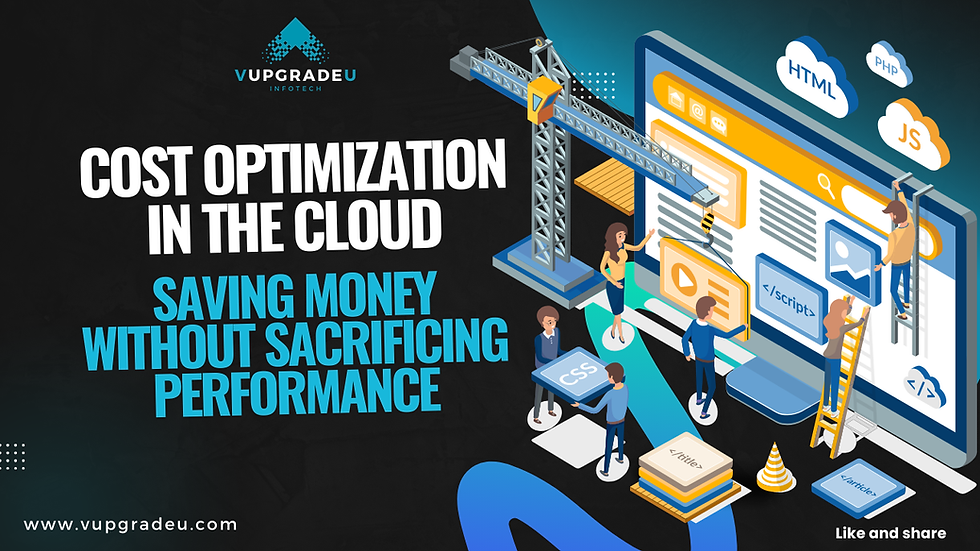Cost Optimization in the Cloud: Saving Money Without Sacrificing Performance
- vupgradeu
- Aug 21, 2024
- 3 min read
The cloud has revolutionized the way businesses operate, offering unparalleled scalability, flexibility, and innovation. However, managing cloud costs can be a daunting task. This blog explores strategies to optimize cloud spending while maintaining performance, comparing major cloud providers like AWS, Google Cloud, and Azure, and providing recommendations for startups and scalable products.

Understanding Cloud Costs
Before diving into optimization strategies, it's crucial to understand the factors influencing cloud costs:
Compute resources: Instances, containers, and serverless functions.
Storage: Object, block, and file storage options.
Networking: Data transfer, load balancers, and VPN connections.
Database services: Relational, NoSQL, and in-memory databases.
Other services: Analytics, machine learning, and IoT platforms.
Cost Optimization Strategies

Rightsizing Instances:
Choose instance types that match your workload requirements.
Utilize instance types with burstable performance for intermittent workloads.
Regularly monitor and adjust instance sizes based on usage patterns.
Leveraging Spot Instances:
Take advantage of spot instances for fault-tolerant workloads.
Implement robust error handling and recovery mechanisms.
Consider using spot instances for batch processing or development environments.
Optimizing Storage:
Select appropriate storage tiers based on data access patterns.
Use object storage for infrequently accessed data.
Implement data lifecycle management policies to automatically tier data.
Networking Efficiency:
Optimize data transfer by choosing the right transfer options (e.g., direct connect, VPN).
Minimize data egress costs by processing data closer to the end-users.
Utilize content delivery networks (CDNs) for efficient content distribution.
Database Optimization:
Choose the right database type for your workload.
Implement database tuning and indexing.
Consider using managed database services with built-in optimization features.
6. Cost Management Tools:
Utilize cloud provider cost management tools (e.g., AWS Cost Explorer, Google Cloud Billing, Azure Cost Management).
Set budgets and alerts to monitor spending.
Analyze cost reports to identify cost-saving opportunities.
Comparing Cloud Providers
Feature | AWS | Google Cloud | Azure |
Pricing Models | On-Demand, Reserved Instances, Spot Instances, Savings Plans | On-Demand, Sustained Use Discounts, Committed Use Discounts, Preemptible VMs | On-Demand, Reserved Instances, Spot Instances, Savings Plans |
Storage Options | S3, EBS, Glacier, EFS | Cloud Storage, Persistent Disk, Nearline, Coldline | Blob Storage, Disk Storage, Archive Storage, File Storage |
Compute Options | EC2, Lambda, Fargate | Compute Engine, App Engine, Cloud Functions | Virtual Machines, App Service, Azure Functions |
Database Services | RDS, DynamoDB, Redshift | Cloud SQL, Cloud Spanner, BigQuery | SQL Database, Cosmos DB, Azure Synapse Analytics |
Export to Sheets
Note: This table provides a simplified overview. Each provider offers a vast array of services with varying pricing models.
Cloud Cost Optimization for Startups and Scalable Products
Startups:
Focus on cost-effective solutions like spot instances, serverless computing, and managed databases.
Utilize free tiers and promotional offers offered by cloud providers.
Implement rigorous cost monitoring and optimization practices.
Consider hybrid cloud or multi-cloud strategies for flexibility.
Scalable Products:
Leverage auto-scaling to adjust resources based on demand.
Employ load balancing to distribute traffic efficiently.
Utilize caching and content delivery networks to improve performance and reduce costs.
Explore serverless computing for event-driven workloads.
Implement cost allocation and tagging for better cost visibility.
Real-World Examples

E-commerce: Use spot instances for batch processing product recommendations, optimize image storage with object storage, and leverage CDNs for fast content delivery.
Media Streaming: Employ auto-scaling to handle peak traffic, utilize content delivery networks for video distribution, and explore cloud-based video processing services.
IoT: Utilize serverless functions for data ingestion and processing, optimize data storage with object storage, and leverage machine learning for predictive analytics.
Conclusion
Optimizing cloud costs is essential for businesses of all sizes. By carefully selecting cloud services, implementing cost-saving strategies, and continuously monitoring spending, organizations can maximize their return on investment while maintaining performance and scalability.


Comments